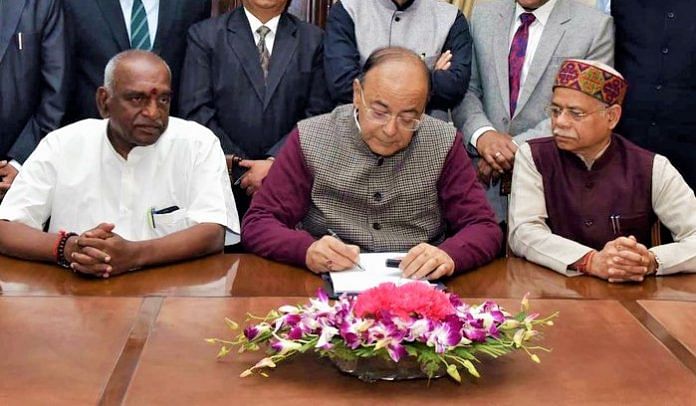The budgeted expenditure doesn’t account for various schemes & announcements that have been made, such as the increase in MSP or the healthcare coverage scheme.
Finance minister Arun Jaitley’s 12,000-word budget speech had many numbers in it about allocations for various schemes, ministries, fiscal deficits, tax revenues and so on. But the most important numbers that underpinned the entire budget theme were 31 per cent, 44 per cent, and 40 per cent.
These are the ruling Bharatiya Janata Party (BJP)’s vote shares in three rural constituencies in Rajasthan that had by-elections recently, for which results emerged just as Jaitley was delivering his budget speech. These numbers represent a nearly 20 percentage point drop in vote shares for the BJP from the previous elections in exactly the same constituencies in 2013 and 2014.
The rural poor in Rajasthan seem to be getting disillusioned with the BJP. Perhaps not just in Rajasthan. What can be done to arrest and reverse this? These are the questions that the 2018-19 budget seemed to want to answer.
Rural voters will now be guaranteed minimum support prices (MSP) for all their produce at 1.5 times their cost of production. They will have access to credit for Rs 11 lakh crore. They will be connected with the electronic national agriculture market (eNAM). There will be 22,000 Gramin Agriculture Markets across the country. There will be a focus to triple agriculture exports to $100 billion. There will be a “long-term irrigation fund”, a “fisheries & aquaculture infrastructure fund”, an “animal husbandry infrastructure fund”, etc.
It is unclear how many of these are radical new initiatives that will put farmers on the promised path to double their incomes, and cajole them into supporting the BJP in the next election too, but that was evidently the objective of the finance minister.
The other big announcement was healthcare insurance coverage of up to Rs 5 lakh for 10 crore poor families. For far too long, healthcare has been a neglected sector, and it deserved the attention it got in this year’s budget. But, was the announcement of this ‘world’s largest healthcare scheme’ a mere boast since, there is no allocation for it in the budget?
When asked, the finance minister said he would ‘find and allocate the money when needed’, but surely, the world’s largest scheme could not have been envisioned without capital allocation? This is where the budget math gets all fuzzy.
Budgeted expenditure is expected to grow nine per cent, which is admirably restrained, given this was a pre-election year budget. But, the budgeted expenditure also does not account for various schemes and announcements that have been made, such as the increase in MSP or the healthcare coverage scheme. So, one is left to wonder if the eventual expenditure will indeed be as restrained as projected. There is equal fuzziness on the revenue side.
There is an astounding four-fold increase in budgeted revenues from cesses and other duties imposed and collected by the Union government – from Rs 32,000 crore to Rs 1.3 lakh crore. It is quite inexplicable that in a GST regime of indirect taxes that accrue to a divisible pool shared by the Centre and states, more than one-tenth of all budgeted indirect tax revenues should be collected separately through cess imposed and collected exclusively by the Union government. So much for cooperative federalism.
One can fully understand that the Centre is nervous about GST buoyancy, and will need more revenues of its own, but a stealthy 2,500 per cent increase in road and infrastructure cess revenues is not the way to ensure revenue visibility for the Centre.
Expectedly, prudent macro-economic policies took a beating in this shift to appease voters, and one cannot begrudge that in a pre-election year budget. In tackling the agrarian distress, anaemic private investment and revenue uncertainty under GST, something had to give, and it was the fiscal consolidation roadmap. The fiscal deficit goals were breached for both FY2018 and FY 2019, which are not alarming by themselves. But one has to remember that this entanglement over revenues and expenditure was entirely self-inflicted, induced by the irrational policies of demonetisation and an untimely GST, and not by any global crisis.
One must laud the finance minister and the Modi government for its consistent focus in eliminating tax arbitrage across jurisdictions, asset classes and time horizons. Starting with the repeal of the Mauritius tax treaty in 2016, which eliminated jurisdiction-based arbitrage, this year’s budget eliminated the equity debt, listed-unlisted equity arbitrage by removing long-term capital gains tax exemption on listed equities. Industry lobbies may feel disappointed about the finance minister not heeding to their clamour for lower corporate tax rates, but in a pre-election year budget, such demands were unreasonable and bound to be unheard.
It was quite ironic that the finance minister boasted that he was “reversing the two-decade old policy of lowering customs duties”, and proposed to increase them for several goods to spur “Make in India”, just ten days after China praised Prime Minister Modi for opposing protectionism in his Davos speech.
Overall, the budget was quite insipid and lacked courage in addressing the three main issues plaguing India’s economy – stagnant farm incomes, dormant private investment, and lack of jobs. Much has been said about the need for India’s economic policy framework to move from outlays to outcomes, from band-aids to surgery, from tactical to strategic, and one hoped that the Modi government, with its absolute parliament majority, would lead the country across that bridge. Alas, that is not to be.
Praveen Chakravarty is senior fellow, IDFC Institute.



